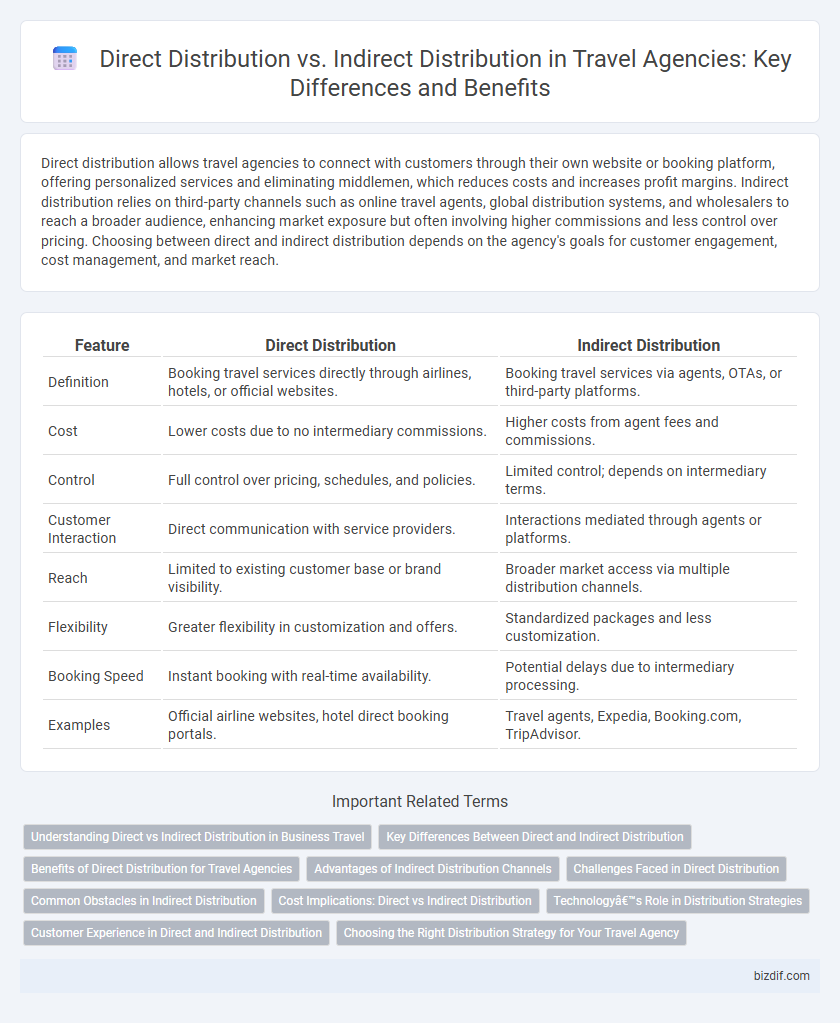Direct distribution allows travel agencies to connect with customers through their own website or booking platform, offering personalized services and eliminating middlemen, which reduces costs and increases profit margins. Indirect distribution relies on third-party channels such as online travel agents, global distribution systems, and wholesalers to reach a broader audience, enhancing market exposure but often involving higher commissions and less control over pricing. Choosing between direct and indirect distribution depends on the agency's goals for customer engagement, cost management, and market reach.
Table of Comparison
| Feature | Direct Distribution | Indirect Distribution |
|---|---|---|
| Definition | Booking travel services directly through airlines, hotels, or official websites. | Booking travel services via agents, OTAs, or third-party platforms. |
| Cost | Lower costs due to no intermediary commissions. | Higher costs from agent fees and commissions. |
| Control | Full control over pricing, schedules, and policies. | Limited control; depends on intermediary terms. |
| Customer Interaction | Direct communication with service providers. | Interactions mediated through agents or platforms. |
| Reach | Limited to existing customer base or brand visibility. | Broader market access via multiple distribution channels. |
| Flexibility | Greater flexibility in customization and offers. | Standardized packages and less customization. |
| Booking Speed | Instant booking with real-time availability. | Potential delays due to intermediary processing. |
| Examples | Official airline websites, hotel direct booking portals. | Travel agents, Expedia, Booking.com, TripAdvisor. |
Understanding Direct vs Indirect Distribution in Business Travel
Direct distribution in business travel involves travel agencies or companies booking services such as flights, hotels, and car rentals directly with suppliers, ensuring greater control over pricing and customer experience. Indirect distribution relies on intermediaries like global distribution systems (GDS) or travel management companies (TMCs) to access and book travel services, often providing broader options and streamlined reporting for corporate clients. Understanding the balance between direct and indirect distribution channels allows travel managers to optimize cost-efficiency, supplier relationships, and traveler satisfaction in corporate travel programs.
Key Differences Between Direct and Indirect Distribution
Direct distribution in travel agencies involves selling services such as flights, hotels, and tours directly to consumers through company-owned websites or physical offices, ensuring greater control over pricing and customer experience. Indirect distribution relies on third-party intermediaries like online travel agencies (OTAs) or travel agents, expanding market reach and attracting a broader audience but often at the cost of reduced profit margins and less direct customer engagement. Key differences include control over inventory and customer data, distribution costs, and the ability to offer personalized services, making direct distribution more suitable for brand-driven strategies while indirect channels excel in volume and market penetration.
Benefits of Direct Distribution for Travel Agencies
Direct distribution enables travel agencies to establish stronger customer relationships by providing personalized services and tailored travel packages. It reduces reliance on intermediaries, increasing profit margins and enhancing pricing control. This approach also facilitates direct access to customer data, allowing for targeted marketing and improved customer retention.
Advantages of Indirect Distribution Channels
Indirect distribution channels in travel agencies enable access to a broader customer base through partnerships with third-party platforms such as online travel agencies, wholesalers, and travel agents. These channels enhance market reach and increase bookings without the overhead costs associated with maintaining a direct sales force. Leveraging established networks also allows for easier entry into international markets and quicker adaptation to changing consumer preferences.
Challenges Faced in Direct Distribution
Direct distribution in travel agencies faces challenges such as high operational costs and the need for advanced technology to manage bookings and customer interactions efficiently. Managing direct consumer relationships requires substantial marketing efforts and personalized service, which can strain resources. Additionally, limited reach compared to indirect channels like online travel agencies (OTAs) can hinder customer acquisition and revenue growth.
Common Obstacles in Indirect Distribution
Indirect distribution in travel agencies often faces challenges such as limited control over pricing, inconsistent customer service quality, and reliance on third-party platforms that can dilute brand identity. These obstacles can lead to reduced profit margins due to commission fees and difficulties in managing real-time inventory updates. Overcoming these issues requires robust partnerships, effective communication channels, and advanced technology integration.
Cost Implications: Direct vs Indirect Distribution
Direct distribution reduces intermediary fees, allowing travel agencies to offer competitive pricing and retain higher profit margins. Indirect distribution channels, such as online travel agents or wholesalers, often involve commissions and markup costs that increase overall expenses. Evaluating these cost implications helps agencies optimize revenue strategies and provide cost-effective solutions to travelers.
Technology’s Role in Distribution Strategies
Technology plays a critical role in shaping distribution strategies for travel agencies by enabling seamless integration between direct and indirect channels. Advanced booking engines, APIs, and real-time inventory management allow travel agencies to distribute products both through their own websites and third-party platforms efficiently. Leveraging data analytics and automation enhances customer targeting and streamlines distribution processes, maximizing reach and revenue across all sales channels.
Customer Experience in Direct and Indirect Distribution
Direct distribution allows travel agencies to offer personalized customer experiences by directly managing bookings, providing tailored travel options, and facilitating real-time communication. Indirect distribution relies on intermediaries such as online travel agencies or wholesalers, which can limit customization but often expands reach and convenience for travelers. Customers benefit from direct channels through enhanced engagement and faster problem resolution, while indirect channels offer broader choice and competitive pricing.
Choosing the Right Distribution Strategy for Your Travel Agency
Choosing the right distribution strategy for your travel agency involves balancing direct distribution channels, such as your website and call centers, with indirect channels like online travel agencies (OTAs) and global distribution systems (GDS). Direct distribution enhances profit margins and customer relationships by eliminating intermediaries, while indirect distribution increases market reach and visibility through established platforms and travel partners. Assessing your target audience, booking volume, and marketing budget will help determine the optimal mix to maximize bookings and maintain competitive advantage.
Direct Distribution vs Indirect Distribution Infographic

 bizdif.com
bizdif.com